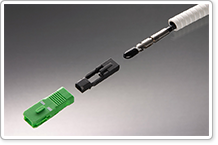 Deploying a fibre optic network can be an expensive business. Installing a new backbone network is a part of this, but delivering fibre from the kerbside to individual buildings is a substantial proportion of the cost. While each connection may not be very long (up to 200 metres) it is often the most complex part of an install as it needs to bend round obstacles between the manhole or cabinet and the premises themselves.
Deploying a fibre optic network can be an expensive business. Installing a new backbone network is a part of this, but delivering fibre from the kerbside to individual buildings is a substantial proportion of the cost. While each connection may not be very long (up to 200 metres) it is often the most complex part of an install as it needs to bend round obstacles between the manhole or cabinet and the premises themselves.
Add in the disruption to the neighbourhood of digging trenches and the need to gain entry to a building to install customer equipment and the difficulty increases even more. Now multiply this by the thousands of buildings that large carriers are looking to connect and you can see how costs increase dramatically. In many cases the last 200 metres are the most expensive of all network deployments.
At PPC we’re focused on helping carriers to bring down the cost and time of installing Fibre to the Premises (FTTP) connections. Our patented Miniflex technology not only protects fibre optic cable but delivers savings in four main ways:
1. Pushable fibreThe innovative design of our Miniflex products mean that fibre optic cables can be quickly and easily pushed as the cables are stiff yet uniquely flexible (or pulled) through our ducts by hand thanks to our low friction DVC liner. Carriers don’t need to use expensive blowing machines and crews trained to use them in order to deliver cable to individual premises, reducing equipment and staff costs.
2. Suitable for micro trenchingMicro trenching reduces disruption by only cutting a 1 inch trench, rather than digging up the entire road or pavement. Our ultra thin direct bury ducts fit perfectly within a micro trench and are able to withstand the 400 degree F (204 c) temperature of the road sealant used to immediately fill in the trench. In AT&T’s Chicago DAS installation, micro trenching with PPC products reduced installation time by 30%, meaning crews could be in at 7pm and out by 10pm in many areas.
3. Pre-connectorised to avoid the need for splicing
Our patented QuikPush system is designed to allow pre-terminated cable to be routed, in the field, without the need for splicing. Available with industry standard connectors it avoids the need to use expensive technicians for installation. Instead, the plug and play design means it can be quickly deployed by fitters, bringing down labour costs dramatically.
4. Flexible but tough
The flexibility of our cable makes it simple to route around obstructions. However it is tough enough to be used inside and outside buildings, in the most extreme conditions, including in service temperatures of up to 80 degrees centigrade. Demonstrating its strength, the same Miniflex cable is protecting fibre on a key instrument on the European Space Agency’s 2018 Mars Mission! Miniflex’s robustness means that fewer cables need to be replaced due to installation damage, further bringing down costs.
Our customers have seen dramatic savings on FTTP installations. In many cases deployments can be deskilled, with fitters used instead of technicians, reducing labour costs. Speed of installation is transformed and ongoing maintenance decreased due to the toughness and reliability of Miniflex.
This translates into savings of up to 50% for customers in the developed world compared to traditional installation methods. Examples include:
- Champaign Telephone Company in Illinois has deployed over 100,000 feet of Miniflex products to connect and network inside commercial businesses, factories and hospitals and other public buildings. Since switching to PPC it has seen a 40% reduction in labour costs combined with faster installation time – technical crews can now complete a 500 feet run of cable in just half a day, allowing next day installations for new connections.
- In AT&T’s Chicago DAS deployment, by using PPC’s patented pushable technology installer Geo-Path has reduced installation time by 30% and cut costs by 70%.
- Installation costs were reduced by 60% when fibre connectivity was provided to iconic ocean liner the Queen Mary, now moored at Long Beach, California.
With fibre rollouts accelerating around the world, bringing down installation costs is vital for carriers. Pushable technology delivers a fast Return on Investment and allows faster, more economical deployments in the crucial last 200 metres.



Comments